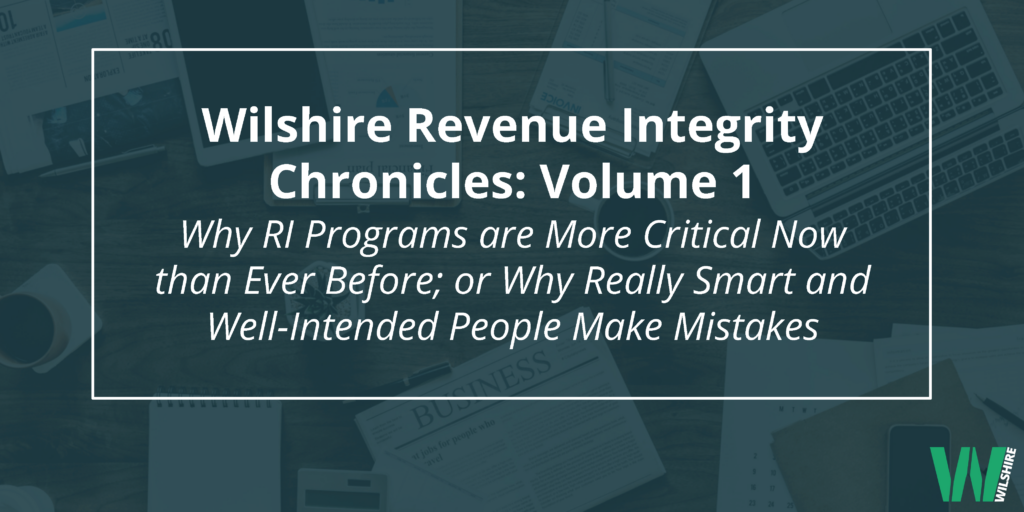Why RI Programs are More Critical Now Than Ever Before; or Why Really Smart and Well Intended People Make Mistakes
We are living in the age of the Electronic Health Record, EHR. Now, more than any time before, most hospital and professional charges are automatically ‘triggered’ off clinical documentation.
According to an Advisory Board study last year on the topic of electronic charge capture, hospitals reported that over 90% of their charges were now triggered automatically in their EHR but only 10% would recommend their current charge capture process!
With the advent of this new paradigm for revenue recognition, why are there still errors? And why are they often more serious?
Based on over 15 years of experience designing and operating Revenue Integrity programs, I believe it is due to 3 main reasons; the inherent nature of change; too many variables to control for in an electronic environment, and changes in electronic systems can affect a much greater proportion of charges in the flip of a ‘switch’.
Following is an example of what Revenue Integrity is and what a Revenue Integrity Department does.
Case study: “Keep Your Eyes on the Prize”
Mutli-hospital healthcare system. All facilities on Epic EHR, some in varying stages of implementation (as acquisitions and mergers develop) (variable #1). Additional implementations of functionality happen on ‘rolling’ schedules (variable #2). Sometimes revenue integrity is involved, sometimes not (variable #3). In this case RI team was involved with the implementation of the anesthesia module at a new system hospital, transitioning from manually posted anesthesia time charges to automatic (change #1). The charge protocol that defines the level of anesthesia given and charged for, for new hospital differs from the main hospital (variable #4). System build occurs, is tested, and vetted with HB and RI teams – all sign off*. Training occurs and the switch is flipped! RI has already created a baseline revenue report based on prior revenue and usage and a RI analyst is tracking revenue weekly after conversion. RI auditors are also randomly reviewing accounts for accuracy. First two weeks everything tracks perfectly. Analyst sending reports to RI management weekly. At the end of week 3 – revenue deeply declines (variable #5). The RI team immediately reaches out to the clinical IT teams to raise alert and informs RI leadership. Within 1 day the teams have the answer to the problem and the solution. There was a change made after go-live (change #3) that unexpectantly impacted revenue. This is where it gets complicated, but with RI it usually does! They needed to allow a charge nurse to override the posting of logs in circumstances where anesthesiologists did not follow workflow (variable #6) – and we all know how users often go off-script. The override security successfully allowed the charge nurse to finish workflow and post logs with charges. What it also did, that was unknown and therefore unexpected and untested (variable #7), was overrode the new facility anesthesia level charges with the old facilities level charges. And revenue shifted accordingly. It one week it impacted 150 accounts.
2 major changes, and 7 variables is all it took to derail revenue with one flip of a switch.
Had it not been for RI keeping their eyes on the prize, this could have been a much longer, bigger impact. There were a few lessons learned.
1. Test all post go live changes. This means negatively testing too – since the desired outcome of the change worked but ended up breaking other things in the system.
2. Alert teams to aberrations immediately to reduce damage and ultimately costly rebilling efforts.
3. The RI team should track the net outcome to revenue as Process Improvement initiative.
Extra tip: do you have revenue guardian checks that ensure your surgical revenue is complete? Rules such as checking surgical accounts for charges with revenue codes 360 (OR time), 370 (anesthesia) and 710 (PACU recovery)?
*RI team involvement can vary from oversight level, just looking at revenue, to deeply involved level, understanding system functionality and how the ‘ghost in the machine’ works. Depending on your organization’s size may determine how involved your RI team can be. I advocate for the later, but it can take time to get to that level. At a minimum, RI must be aware of all system changes that impact revenue BEFORE changes are made and MUST track revenue from baseline through transition.

